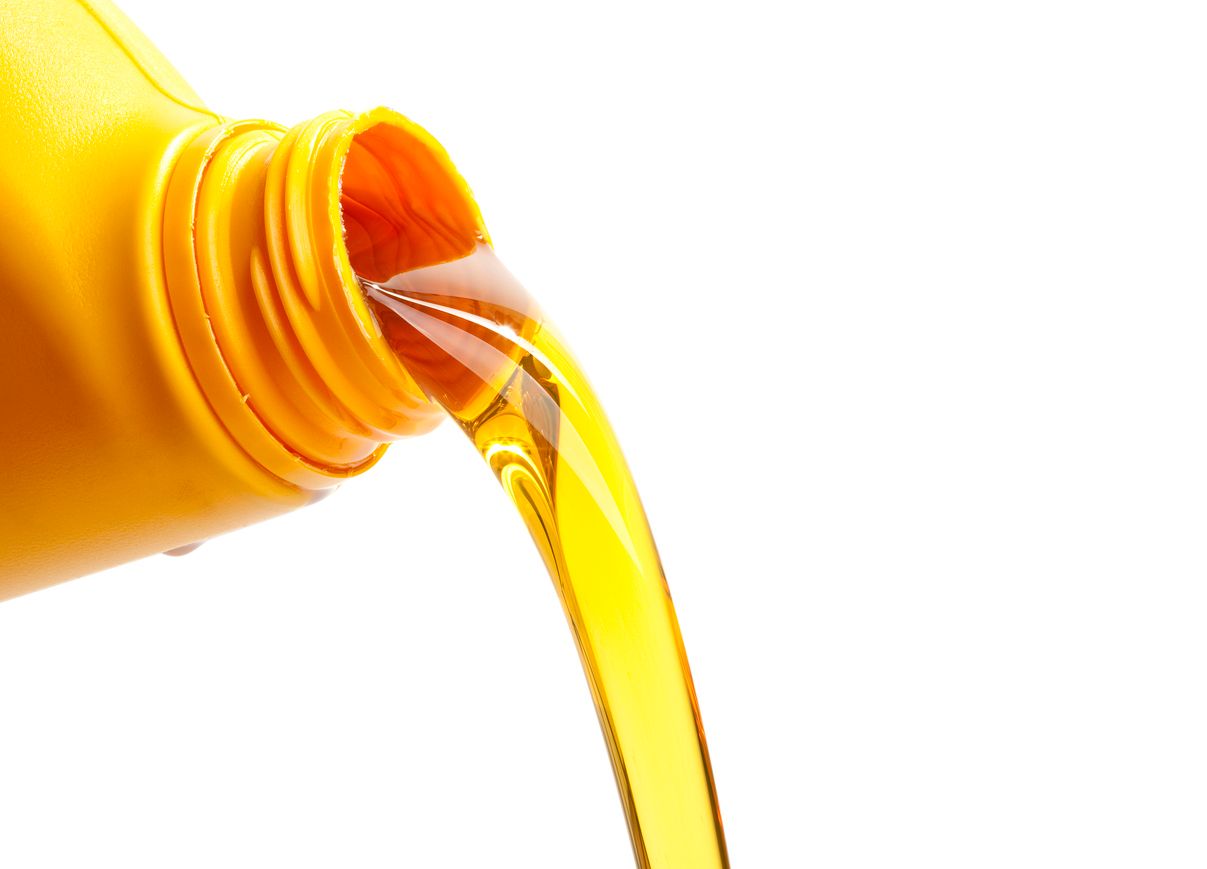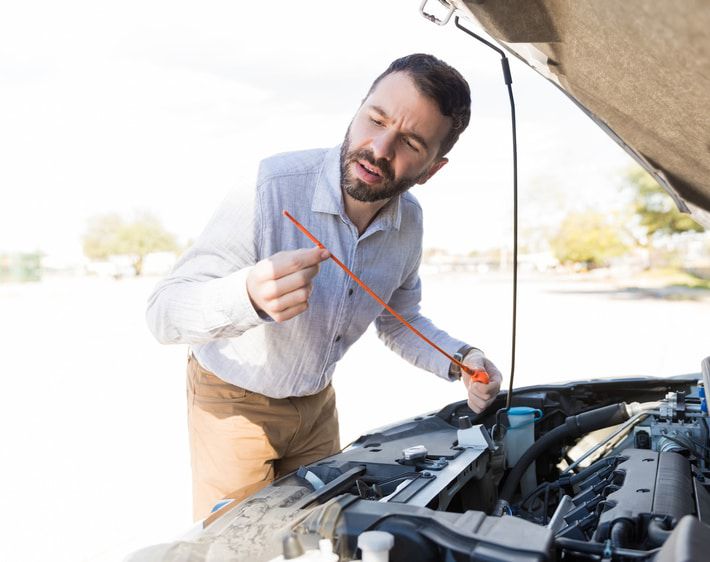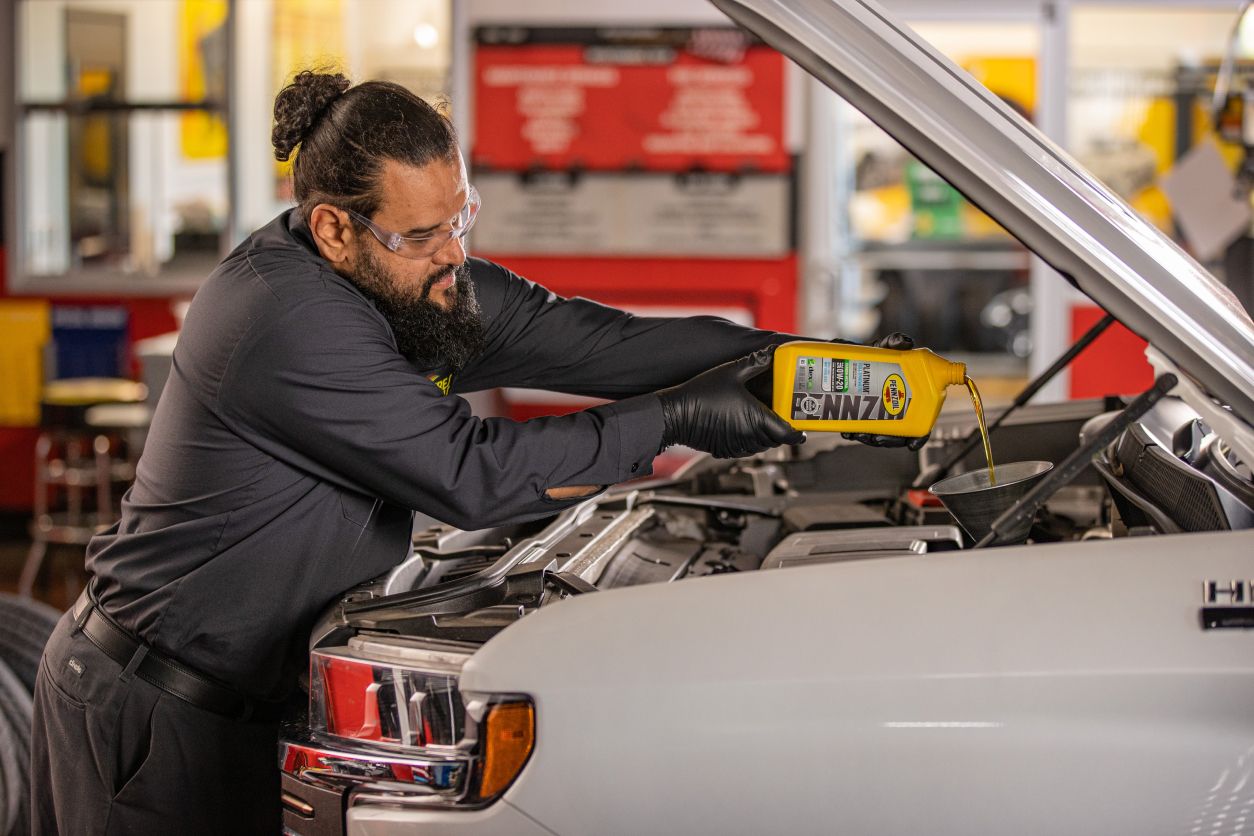When your low-pressure engine oil light illuminates, the questions are endless. What does it mean? What makes oil pressure low? What should you do if this happens while you're driving? Read on to learn what low oil pressure means, what causes it, and how to navigate the issue safely if it happens to you.
What Does It Mean When Your Oil Pressure Is Low?
Low oil pressure means you don’t have enough oil or your engine isn’t generating enough pressure to circulate its oil to crucial components.
Loss of Oil Pressure: Causes
What makes oil pressure drop faster than a wrench in an engine bay? Here are the most common culprits of low oil pressure:
1. Oil Leaks
Oil leaks are a frequent cause of low oil pressure in engines, as they can gradually deplete oil levels without immediate signs of trouble. Common leak sources include gaskets, seals, and the oil pan, but even a loose oil filter can cause a leak. If you frequently have to top off your oil or notice oil spots beneath your vehicle, a professional inspection is recommended to locate and repair the leak.
By scheduling regular oil changes, you can help avoid low engine oil in the first place. Check oil levels between oil changes to ensure your car isn’t running with less engine oil than it needs. Not sure if your vehicle needs an oil change? Here are six signs you need one now.
2. Incorrect Oil Viscosity
The wrong oil viscosity, particularly a lower viscosity than recommended in your car’s owner manual, is often what causes low oil pressure in an engine. Lower viscosity oil can produce less resistance to flow, leading to the oil pressure drop. Don’t be fooled, though — a higher-viscosity oil isn’t automatically safer. If it’s higher than the manufacturer’s recommendation, it can create resistance to flow, leading to poor engine lubrication.
3. Dirty Oil Filter
Can a dirty oil filter cause low oil pressure? You bet! The oil filter traps potentially harmful debris so it never reaches your engine. If not changed regularly, it can become too clogged to do its job efficiently. Oil filters also include pressure relief valves, which, if the filter is blocked, will let oil bypass the filter element and flow freely.
But before the oil filter clogs enough to bypass the filter media, the flow through the oil filter can be restricted enough to reduce engine oil pressure. To avoid low engine oil pressure, replace your oil filter during each oil change, like we do at Tires Plus.
4. Faulty Oil Pressure Sensor
It’s also possible that you may not have an oiling problem at all. Your oil sensor detects oil pressure levels and relays that information to your vehicle’s dashboard. As such, a defective oil pressure sensor can trigger a false warning light. Fortunately, a diagnostic test can determine whether the issue lies with the sensor or if an actual oil pressure problem requires your attention.
5. Bad Oil Pump
Problems with your oil pump can stem from any number of issues, including oil contamination or a clogged oil pickup tube. It’s essential to repair or replace a faulty pump immediately since it plays a critical role in distributing oil to your engine's components.
Have your Tires Plus technician check to see if the culprit for your pump’s failure is just age and wear or if there is possible contamination, issues with your oil level, or poor oil maintenance.
6. Engine Wear
Engine wear is one of the less common reasons for what makes oil pressure low, but if you can’t seem to get to the bottom of your oiling issue, this could be your culprit. Even if you’re using the correct oil, your pump is functioning properly, and your sensor is reading correctly, you can still experience low oil pressure if your engine is high mileage. Engine parts wear down over time, leading to increased internal clearances. As these clearances grow, oil flows more freely, which can result in lower oil pressure.
While not a common cause of low oil pressure, widened clearances between pistons and cylinders can also cause more oil consumption. When this happens, your engine might use up oil faster than it should, reducing the overall oil volume and affecting pressure. While some oil consumption is typical, excessive consumption can indicate wear in critical engine components and should be addressed promptly.
Fortunately, regular maintenance and high-mileage engine oil can help mitigate these effects. High-mileage engine oils are often formulated to maintain viscosity and protect aging components.
Symptoms of Low Engine Oil Pressure
Oil Warning Light
If the oil pressure drops below an appropriate level, your sensor may activate your oil warning light on the dashboard. If you see your engine oil pressure light on, find a safe place to pull over — ideally a parking lot, gas station, or service station — and check your oil level. But even if the oil level is correct, having it towed to a repair shop is still recommended. The issue may be as simple as a faulty oil pressure sensor, or you could have a more significant problem.
Diminishing Engine Performance
If your engine suddenly loses power, stalls out, or burns through fuel faster, you may be experiencing diminishing engine performance. While this drop could indicate several automotive issues, a common cause is low engine oil pressure. So, start small and check your oil level to see if you need a simple oil and filter change.
Burning Oil Smell
A burning oil smell could mean your vehicle is leaking oil, which could be hitting hot surfaces like the exhaust components on your car. Since this smell typically indicates a leak, which can cause low oil pressure, we recommend finding a gas station or parking lot where you can safely pull over to check your oil level if you smell burning oil while driving.
Engine Noise
When your engine oil is running low, your engine's components don’t receive the lubrication they need to function correctly. An engine without lubrication is an unhappy one — you may hear clunking, knocking, ticking, or grinding noises from the engine bay. In this case, you'll want to stop driving as soon as possible and get your car serviced by a professional technician.
Engine Overheating
Engine overheating can be a complex issue. While it isn’t always caused by low engine oil pressure, it certainly can be, as engine oil lubricates and helps cool your engine’s moving parts. Without sufficient oil pressure, your car’s engine will generate more friction, producing excess heat. Worst of all, an overheating engine means tighter engine tolerances, which subjects components to undue (and often extreme) wear and stress, exacerbating the issue.
What to Do if You Have Low Engine Oil Pressure
Low oil pressure isn’t something you should ignore. By proactively identifying and addressing the issue's root, you can prevent major engine problems and costly repairs. Stay ahead of motor oil issues, and visit your local Tires Plus for any necessary maintenance and a full-service oil change today!
Low Oil Pressure FAQs Answered:
Can You Drive a Car With Low Oil Pressure?
If you care about your vehicle, the answer to this question is a solid “no.” If your oil pressure light comes on while driving, find a safe place to pull over and park, shut the vehicle off, and call for a tow. If you continue driving with low oil pressure, you can cause significant damage to your engine.
How to Diagnose Low Oil Pressure
Begin by checking the oil level, looking for leaks, and ensuring the correct oil viscosity is used. If these factors are not the issue, a professional technician at Tires Plus can inspect the oil pump, pressure sensor, and internal components for further diagnosis.
How to Choose the Right Engine Oil
When in doubt, always use the oil recommended in your owner’s manual. If you can no longer access your owner’s manual, you can typically find it on your vehicle manufacturer’s website. If you’re unsure what type of oil to use, stop by one of our locations — our trained technicians can look up the recommended oil for your specific make, model, mileage, and driving conditions.


